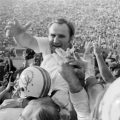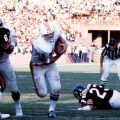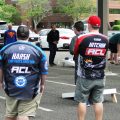What Caused The Decline of NASCAR? A Former Reporter’s Thoughts
In the early 2000s, NASCAR was soaring. It may be difficult for younger people to imagine it, but the sport was once poised to overtake the NFL in popularity. Yes, that’s actually true; read it again if you need to. So what caused the decline of NASCAR to the point where the sport is desperately trying to remain relevant?
I covered NASCAR for six seasons for two excellent racing websites, That’s Racin’ (the Charlotte Observer’s racing site) and the Frontstretch. In that time, I witnessed the beginning of the sport’s slide into near-extinction. I’m also someone who became a disenchanted former fan myself.
Having followed the sport in the time frame when it began, I can offer what I believe are the real reasons for the decline of NASCAR. I can also dispute other reasons for it that I see being offered today. This is all just ultimately my opinion, but it’s a carefully considered one.
I’ll start with a few things that I don’t believe caused the decline of NASCAR, then I’ll share what I think really did.
The Decline of NASCAR, Non-Reason #1: The Cars Are Too Spec
I’ll submit that this is a reason a few fans I know stopped watching the sport. In NASCAR’s pre-1990s heyday, when it was still very much a regional sport, manufacturer identity was a big thing. People rooted for car brands as well as drivers, and car companies believed in the whole “win on Sunday, sell on Monday” mantra.
However, by the time NASCAR was peaking in the early 2000s, there already wasn’t much manufacturer identity left. The cars already were mostly spec at that point, and the sport was doing just fine…booming even. The decline of NASCAR from dominance started circa 2005, and there wasn’t any big change to car specs in that time period.
All that said, the unveiling of the “Car of Tomorrow” in 2007 certainly didn’t help. It was boxy, ugly, and top heavy…and its shape was part of the reason for the Indianapolis debacle of 2008. In that race, caution flags were flown almost every ten laps for tire wear, as Jimmie Johnson limped to a victory. The fan backlash was loud and intense. If any single event hastened the decline of NASCAR, it was Indy 2008.
But in a relatively short time, NASCAR corrected the car and the multiple issues with its design, and while the cars don’t differ by manufacturer like they once did, at least we’re not seeing disastrously awful races just because of the car’s construction. In fact, the current car lends itself to some pretty good racing.
Lack of manufacturer identity may have been a reason some hardcore fans left the sport in the early 1990s, but that doesn’t seem to me to be a valid reason for the sport’s popularity plunge since 2005.
The Decline of NASCAR, Non-Reason #2: It’s Gotten Too Safe
I’m not sure why people would think this, although I’d actually had some heated debates with Tom Bowles at the Frontstretch about it. Bowlesy thinks there needs to be an element of risk for racing to be exciting; I don’t tune in to races to see a car potentially fly into a catch fence and injure spectators.
NASCAR did (and still does) market the possibility of spectacular wrecks. I’ll never forget seeing Elliott Sadler’s terrifying end-over-end crash at Talladega in 2003 – and seeing it again in every single ad for Talladega races for the next 3-4 years. Maybe there is a segment of fans who tune in for death-defying calamities, but that has always been a part of the sport and still is.
I can’t imagine any fan of Dale Earnhardt Sr.…and there were a lot of them…not wanting to see the sport take every measure it could to keep drivers safe after Daytona 2001. This isn’t to say that the initial Car of Tomorrow wasn’t a disaster…it was…but at the time, fans were plenty vocal about safety after the loss of the sport’s biggest icon.
For any fan that needs racing to be dangerous, there are still four restrictor plate races on the schedule. But plate racing still sucks…not only do plates produce multi-car crashes every event, they pervert the standings because of it.
I’m not buying the “it’s too safe” bit as a cause for the decline of NASCAR. Racing is still pretty danged dangerous. Just because no one has been killed at the Cup level since Earnhardt’s death doesn’t make it less so.
The Decline of NASCAR, Possible Reason #1: Jimmie Johnson’s Winning
Jimmie Johnson was a hallmark of ruthless efficiency in his prime, winning seven titles and five in a row. With his brilliant head wrench Chad Knaus on the pit box, the #48 team for years remorselessly laid the field to waste when playoff time started.
Jimmie won a lot. Which meant that other drivers didn’t win a lot. If that contributed to NASCAR’s decline, however, that is on NASCAR.
NASCAR possessed one of the greatest dynasties in the history of sports during Jimmie’s reign. Yet instead of focusing their marketing on Johnson’s unequaled supremacy, NASCAR chose to put all of their marketing eggs into the Danica Patrick basket, believing a swimsuit model who could drive a racecar would save the sport.
Danica turned out to be a huge bust…as many people who followed the sport closely, including yours truly, predicted she would be. (It wasn’t a tough call to make, if you actually looked at her results instead of her figure.)
Dynasties like Johnson’s aren’t bad for a sport…unless the sport doesn’t know how to market them. The Yankees were always good for baseball. Tiger Woods was great for golf. The Patriots’ domination was great for the NFL. People love a winner, they love to hate a winner, and they love to see a dynasty get taken down. The #48 team should have been a gold mine.
So no, Johnson’s domination wasn’t directly a factor in the decline of NASCAR – but their failure to market it most definitely was.
The Decline of NASCAR, Possible Reason #2: Dale Earnhardt Jr.’s Losing
By virtue of his father’s untimely passing, Dale Earnhardt Jr. instantly found himself with a larger fan base than any three drivers in NASCAR. As the son of one of the greatest racecar drivers in history, Junior also had an impossible standard to live up to.
But for whatever reason, Junior not only didn’t measure up to his father’s formidable reputation, he rarely even established himself as a contender. Much like Kyle Petty, he ultimately became more known for his good-guy personality and his lineage than for his achievements on the racetrack. As Junior’s fortunes continued to trend downward even while driving for the strongest team in the sport, his fan base became turned off. And he had a very large fan base.
It could be argued that Junior was the sport’s last link to its tobacco-chewing, Southern past; once Jeff Gordon tore up the sport, drivers started to appear from every corner of the country. But the sport’s most dedicated fans were (and are) still in the Southeast, and Southerners are loyal to the core to their heritage.
It’s possible that the most popular driver not performing well hurt the sport, given the sport’s fan demographic. However, like Johnson’s dominance, I doubt that this would have been as much of a problem were it not for other factors that were far more damaging.
So here are three actual reasons for the decline of NASCAR. Still with me? OK, here we go.
The Decline of NASCAR, Actual Reason #1: The Chase
One of Brian France’s very first acts as CEO of NASCAR sealed his doom as a respectable heir to a business, and nothing he did for the rest of his tenure would change that perception.
I don’t often see NASCAR’s ill-conceived playoff idea as a reason people cite for the decline of NASCAR in articles I read these days, but I promise you, that was not the case when I covered the sport. NASCAR’s initial playoff brainchild was hugely unpopular, and every griping fan in comment sections of blogs everywhere had the artificial points reset near the top of their list of complaints.
It’s not so much that the points reset NASCAR introduced in 2004 was a monumentally stupid idea. It was, but even that wasn’t the point. It was the insistent implementation of it over loud objections of fans. NASCAR polled fans about the idea on their website following the 2003 season, and fans overwhelmingly rejected it. They shut down the polls and went ahead with it anyway.
If you want to attribute the decline of NASCAR to arrogant leadership, look no further than that single act. It was blatant condescension towards what was arguably the most loyal fanbase in sports. Why poll the fans if you’re just going to ignore them?
That and it really was a stupid idea.
In case you weren’t there or don’t remember, in 2004 NASCAR welcomed their new series sponsor, Nextel (now Sprint), with a new “playoff” system called the “Chase”. After 26 of 36 races, the top ten drivers would have their points reset, putting them all on a level playing field again for the last ten races.
Yes, NASCAR actually believed an artificial points reset after two thirds of the season was the move that was going to catapult them past the NFL.
Making matters worse, within four years, the driver with the second largest fan base finished with the most points in a season twice, only to lose the title to a points reset.
It’s not often noticed, but it was definitely noticed by Jeff Gordon fans: had NASCAR not implemented the Chase, the driver of the iconic #24 could have been the one standing aside Dale Earnhardt and Richard Petty today with seven titles, instead of his protégé Jimmie Johnson. Gordon scored the most points overall of any driver in 2004, 2007, and 2014. Nothing against Jimmie Johnson for winning titles with the rules as written, but he only managed that feat twice.
Gordon wasn’t the only driver who turned in a spectacular season-long performance only to have it nullified. In 2008 Kyle Busch smoked the field for the first 26 races, winning eight of them and setting the NASCAR world on fire with his brash and unapologetic racing style. After two DNFs in the first two Chase events resulting from simple bad luck, just like that his title hopes were gone. I was critical of the Chase in plenty of columns, but I felt like I really got the point across with this one about it.
It’s largely forgotten now, because the sport’s current elimination format playoff system at least had some thought put into it. It rewards winning, which rewards fighting for wins, which creates rivalries.
But the initial “Chase”, an artificial and contrived points reset, was despised by fans. It was a radical change to a sport that didn’t need radical changes. You could say it was NASCAR’s New Coke, except Coca-Cola was smart enough to change the formula back in response to furious customer backlash.
If they hadn’t, you’d probably be reading articles today about the decline of Coca-Cola too.
The Decline of NASCAR, Actual Reason #2: The Broadcasts
I don’t need to tell anyone who was a fan in the 2000s this, but NASCAR’s broadcasts at the time may have been the worst in the history of sports. Fox Sports’s coverage was particularly abominable, with a seemingly endless parade of commercial interruptions mixed with the Ford Cutaway Car, the Home Depot Pit Crew Member, the Viagra Boner Of The Race, whatever, all during green flag racing.
Mike Joy is an outstanding announcer, and it was never a big deal for a fan to mute Darrell Waltrip’s exponentially annoying “boogity boogity boogity!” at the green flag. But it was a never ending source of irritation to see five laps of racing followed by a several minute commercial break, which was then followed by another minute of a wide angle shot of the venue and “This race is being brought to you by <several companies who also paid an obscene amount of money to NASCAR>.”
There were often times…and I’m not exaggerating this…when a viewer would see maybe five laps of racing, a two-minute break, and then just two more laps of racing before another break. Anyone who was watching then could tell you that wasn’t unusual at all.
This was a problem that actually needed to be addressed and wasn’t. NASCAR blew off fan demand for picture-in-picture commercial breaks…something they’ve since embraced…while Fox Sports’s indifference to fans went completely unchecked. It was another case of costly arrogance; as much as fans loved NASCAR, they didn’t love it enough to put up with an endlessly saturated marketing campaign featuring occasional snippets of racing each week.
One shining example was a 2010 Dover race…a “playoff” race, no less…where ESPN broke away with 11 laps to go in a very much undecided event for an ad break. Dover is a 1-mile track, and 11 laps does not take long. I remember watching it and literally wondering if I was going to see the finish of the race. I wasn’t the only one who noticed…as this blog post’s comments demonstrated.
NASCAR made an absurd amount of money with their television contracts in the 2000s, but that ultimately cost them a sizable chunk of the audience when networks were forced to make it worth their while. The broadcasts really were over-saturated with ads enough to drive fans away.
And I said all that without even bringing up that profoundly irritating cartoon gopher.
The Decline of NASCAR, Actual Reason #3: The Venues
Speaking of disrespecting your fan base, how about needlessly putting an end to a beloved 54-year tradition? That’s exactly what NASCAR did when they took the Labor Day race out of Darlington and sent it to Auto Club Speedway in California. It took quite a few years of longtime fans bitching about that, but NASCAR did finally move the Labor Day Southern 500 back to Darlington.
The move of the Labor Day race to California was part of an ongoing trend. In response to its rapidly growing popularity nationwide, NASCAR moved away from the Southeast fans who brought the sport to the dance, and began holding races in places like Vegas, Chicago and Los Angeles.
But that in itself wasn’t necessarily the crime. You couldn’t entirely blame NASCAR for no longer holding events in places like North Wilkesboro or Rockingham or even Darlington, which lost a race on the schedule for several years. The markets simply couldn’t support them anymore.
The problem was the tracks that replaced them…nearly all of them were characterless, cookie-cutter speedways where aero package ruled the day. In 1994, there were six events held at intermediate tracks of 1.5-2 miles in length. Just ten years later, there were 13 such events…nearly half the schedule.
That isn’t insignificant when it comes to explaining the decline of NASCAR. When you think of the venues that have showcased the most memorable events in the sport’s history, Daytona, Darlington, and Bristol often come to mind. Atlanta has had some classics, but that was partly by virtue of the venue hosting the championship race, such as Alan Kulwicki’s unforgettable title win in 1992.
NASCAR moved away from tracks where drivers push and shove and fight both other racecars and the track, and moved to aero-dependent speedways where engineers in the garage determined winners. As a result, teams with more resources…such as Hendrick Motorsports and Roush Racing…won big for years.
But more importantly, the racing isn’t anywhere near as exciting at the cookie cutters, as I so eloquently explained here. I also suggested a solution…that NASCAR emulate how baseball exploded in popularity after the opening of Camden Yards. Even more so than in baseball, the on-screen product is affected with the layout of a track. It makes a world of difference watching on TV.
You also don’t often see post-race fisticuffs after races at Kansas or Vegas like you might at Martinsville or Bristol. Those moments generate interest…and rivalries, which every sport needs.
Fortunately, NASCAR is finally addressing this…
How NASCAR Can Rise Again
I have reasons to believe that NASCAR can return to previous levels of popularity…maybe not on the verge of overtaking the NFL again, but at least back to a point where they have enough of a dedicated fanbase to be a solid performer in ratings and ticket sales.
Since this is a non-ideological blog, I won’t get into the things that the NFL, NBA and MLB have recently done to drive away a significant portion of their fanbases. We all know what I’m talking about. I expect that will be a boon to NASCAR’s future.
As I’ve said, the sport is finally addressing its venue problem. The 2021 campaign includes six road course races, a dirt race at Bristol (!), and a race at the concrete venue of Nashville for the first time. Labor Day is in Darlington where it belongs, and Darlington is hosting two events again. And the season will conclude at Phoenix again, a more exciting venue than Miami where the finale had been for years. There are still 11 races on “intermediate” tracks, but it’s finally moving in the right direction.
These are bold changes, but this variety of tracks will test drivers and teams at every level. No longer will teams win titles by dominating speedways; driver skill will be more of a factor, as it should be.
In addition, the current playoff format, while far from perfect, isn’t nearly as unpalatable as the Chase was. It rewards winning and risk taking, where the Chase rewarded points racing and avoiding risk. Yes, a team can still dominate all season and lose a championship to a flat tire, but at least it’s not just an artificial points reset. With the current playoff point structure, drivers are also somewhat rewarded for strong season-long performances as well…while the Chase completely disregarded excellence during the season.
The broadcasts have also improved. There are still plenty of obscene profit breaks, but it’s far less aggravating when you can still see the action and leader board on part of the screen. NASCAR was plenty defiant resisting this idea at their peak…but these days, they’re not in a position to ignore displeased fans.
The sport no longer has Dale Earnhardt Jr. or Jimmie Johnson, so there’s an opportunity for new fan favorites to emerge, formed by on-track performance rather than sentiment. Veterans like Kyle Busch and Kevin Harvick are future Hall of Fame drivers with fairly large followings, and a strong crop of young drivers are making names for themselves.
NASCAR’s 2020 champion is also its most popular driver…for the first time since 1988. Chase Elliott, like his 1988 champion father Bill, is from Dawsonville, Georgia…the Southeast…and he has the lineage factor as the son of a well-liked champion. Nepotism isn’t dead in NASCAR. Elliott is a great driver and a likable kid, and he doesn’t take any crap…he doesn’t shy away from wrecking a driver like Denny Hamlin if the situation called for it. (It did.) He is likely to build a fan base fast.
The decline of NASCAR was a combination of ill-considered decisions: the implementation of a contrived playoff, poorly thought out broadcasting contracts, and departing from unique and venerable venues for dull, unexciting ones. It didn’t help that a hugely popular driver underperformed, but that shouldn’t have caused this much of a free fall.
After years of seeing its once enormous audience dwindle to almost nothing, NASCAR is finally righting the ship. Ousting Brian France, who created the Chase and presided over the sport’s decline, was no small part of that. But they’ve also improved the schedule, the broadcasts, and the method of determining a champion. It took time, maybe too much time, but NASCAR is finally addressing the three biggest reasons for the decline of the sport.
And while 2020 has been anything but usual especially in the sports world, NASCAR was the one sport that didn’t suffer a significant ratings drop. For the first time in over a decade and a half, they seem to be headed in the right direction.
So if I’m right, in a few years NASCAR may become America’s summer sport again.
And maybe this time, they will have learned from their mistakes.
Did this post make your day a little bit?
I hope so. If it did, I would really appreciate your support.
When you use this link to shop on Amazon, you’ll help subsidize this great website…at no extra charge to you.
Thanks very much…come back soon!
Photo credit: brandonzeman on Visual Hunt / CC BY-SA
Photo credit: Zach Catanzareti Photo on Visualhunt.com / CC BY-SA
Photo credit: wjarrettc on Visual hunt / CC BY
Photo credit: sidehike on VisualHunt / CC BY-SA
Photo credit: Zach Catanzareti Photo on Visualhunt / CC BY-SA
Photo credit: PresidenBertho on Visualhunt.com / CC BY-SA
Photo credit: sarahstierch on Visualhunt.com / CC BY
Photo credit: tequilamike on Visual hunt / CC BY
Photo credit: Zach Catanzareti Photo on VisualHunt.com / CC BY-SA
Photo credit: Zach Catanzareti Photo on Visualhunt / CC BY-SA
Photo credit: sidehike on Visual hunt / CC BY-SA
Photo credit: Darryl W. Moran Photography on Visual Hunt / CC BY-ND
Photo credit: eliduke on Visualhunt.com / CC BY-SA
Photo credit: Ford Racing on VisualHunt / CC BY
Photo credit: royal_broil on Best Running / CC BY-SA
Photo credit: PDA.PHOTO on Best Running / CC BY-ND
Photo credit: balpeck on Best Running / CC BY-SA
Photo credit: “Fast” Eddie Maloney on Best Running / CC BY-SA
Photo credit: Zach Catanzareti Photo on Best Running / CC BY
Photo credit: Zach Catanzareti Photo on Best Running / CC BY
Photo credit: Zach Catanzareti Photo on Best Running / CC BY-SA






















